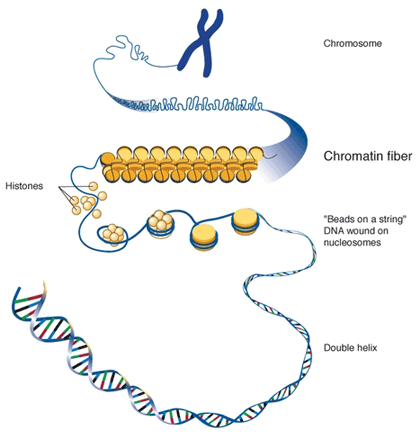Human beings, like other organisms that reproduce sexually, start life from a zygote or fertilised egg.
Later, trillions of cell divisions take place in a controlled way to lead to a complex multicellular human being, or in other words, a single cell is the common ancestor of the rest of the organism’s cells.
Even when a living being has developed completely, cell division is still necessary for the development, maintenance and repair of cells and tissues. This division is strictly regulated to avoid consequences that might be fatal for that organism.
Later, trillions of cell divisions take place in a controlled way to lead to a complex multicellular human being, or in other words, a single cell is the common ancestor of the rest of the organism’s cells.
Even when a living being has developed completely, cell division is still necessary for the development, maintenance and repair of cells and tissues. This division is strictly regulated to avoid consequences that might be fatal for that organism.
Cell division
Cell reproduction via the cell cycle constitutes the foundation that enables the continuity of life from one cell to another. This cycle, strongly regulated, includes the diverse stages of a cell life from the division of a single parent cell to the reproduction of two new daughter cells.
Before going on with the cell reproduction process, it is necessary to understand the function and structure of the genetic information of a cell.
The number of chromosomes[1] of eukaryotic cells varies depending on the species.
In human beings, body cells (somatic cells) have 46 chromosomes, while sex cells or gametes (eggs and sperm) have 23 each.
Somatic cells have two sets of chromosomes (2n[2]) in a configuration called diploid.
Gametes, that have a single set of chromosomes, are designated as 1n and they are known as haploid cells.
Genes (functional units of the chromosome) determine particular features by coding specific proteins, to represent variations in specific features. For instance, eye colour is a characteristic whose traits can be brown, blue or green.
These traits in an individual are established by the inherited genes from each parent.

The number of chromosomes[1] of eukaryotic cells varies depending on the species.
In human beings, body cells (somatic cells) have 46 chromosomes, while sex cells or gametes (eggs and sperm) have 23 each.
Somatic cells have two sets of chromosomes (2n[2]) in a configuration called diploid.
Gametes, that have a single set of chromosomes, are designated as 1n and they are known as haploid cells.
Genes (functional units of the chromosome) determine particular features by coding specific proteins, to represent variations in specific features. For instance, eye colour is a characteristic whose traits can be brown, blue or green.
These traits in an individual are established by the inherited genes from each parent.
If the DNA of those 46 chromosomes in a human cell unfolded from one end to the other, it would measure around 2 metres and its diameter just 2 nm. Taking into account that the typical size of a cell is about 10 μm, DNA has to condense itself to fit into the cell nucleus and must be quickly accesible so that genes can be expressed.
During several phases of the cell cycle, the long chains of DNA are highly condensed in the chromosome. There are a number mechanisms by which chromosomes are compacted, in all of them various classes of proteins help to organise and pack the chromosomal DNA.
In the first level of compaction, DNA is strongly packed around a core of eight structural proteins (histones) in regular intervals along the chromosome, forming the structure known as chromatin.
The fundamental unit of organisation for chromatin in eukaryotic cells is the nucleosome, composed of a DNA fragments around 200 base pairs (bp) long and a histone octamer (group of eight). This structure compacts seven times the DNA molecule which under a microscope looks like a ‘necklace of beads’ with a 10 nm diameter.
The fundamental unit of organisation for chromatin in eukaryotic cells is the nucleosome, composed of a DNA fragments around 200 base pairs (bp) long and a histone octamer (group of eight). This structure compacts seven times the DNA molecule which under a microscope looks like a ‘necklace of beads’ with a 10 nm diameter.
In the second level of compaction, the nucleosome fibres and the linker DNA[3] roll into 30 nm fibres (DNA molecule is now 50 times packed).
The third level of compaction uses fibrous proteins to compact chromatin, creating radial loops of 250-400 nm long. These proteins make sure that each chromosome in the non-dividing phase occupies a certain area in the nucleus avoiding overlap.
In higher levels of organization we find chromatids (700 nm - 1μm long). When two of these chromatids join, through a region called the centromere, they form metaphasic chromosomes[4].
[1] Highly organized structures comprising DNA and proteins, which contain most of the genetic information of an individual.
[2] n indicates the number of chromosome sets.
[3] DNA regions that are not transcribed and are located between genes.
[4] Metaphase: second phase of mitosis (cell division) in which the nuclear membrane is removed and the chromosomes are placed in the equator of the cell.
[2] n indicates the number of chromosome sets.
[3] DNA regions that are not transcribed and are located between genes.
[4] Metaphase: second phase of mitosis (cell division) in which the nuclear membrane is removed and the chromosomes are placed in the equator of the cell.
Sources: OpenStax College, Biology. OpenStax College. 30 May 2013.
https://www.quora.com/What-are-the-differences-between-chromosomes-chromatids-and-chromatin
https://burningscience.wordpress.com/biology/dna-structure-and-replication/
http://27.109.7.67:1111/econtent/cell-communication/principles-part-3.php
https://www.quora.com/What-are-the-differences-between-chromosomes-chromatids-and-chromatin
https://www.quora.com/What-are-the-differences-between-chromosomes-chromatids-and-chromatin
https://burningscience.wordpress.com/biology/dna-structure-and-replication/
http://27.109.7.67:1111/econtent/cell-communication/principles-part-3.php
https://www.quora.com/What-are-the-differences-between-chromosomes-chromatids-and-chromatin






Your opinion matters